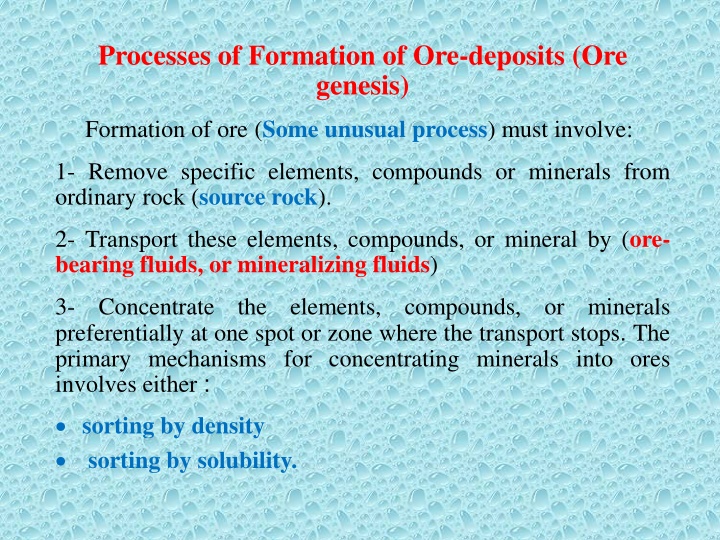
Formation of Ore Deposits: Processes and Mechanisms Unveiled
Delve into the intriguing processes of ore genesis, involving the removal and transport of specific elements to create valuable mineral deposits. Learn about internal and external mechanisms shaping ore formation through magmatic concentration, hydrothermal processes, sedimentation, and more.
Download Presentation

Please find below an Image/Link to download the presentation.
The content on the website is provided AS IS for your information and personal use only. It may not be sold, licensed, or shared on other websites without obtaining consent from the author. If you encounter any issues during the download, it is possible that the publisher has removed the file from their server.
You are allowed to download the files provided on this website for personal or commercial use, subject to the condition that they are used lawfully. All files are the property of their respective owners.
The content on the website is provided AS IS for your information and personal use only. It may not be sold, licensed, or shared on other websites without obtaining consent from the author.
E N D
Presentation Transcript
Processes of Formation of Ore-deposits (Ore genesis) Formation of ore (Some unusual process) must involve: 1- Remove specific elements, compounds or minerals from ordinary rock (source rock). 2- Transport these elements, compounds, or mineral by (ore- bearing fluids, or mineralizing fluids) 3- preferentially at one spot or zone where the transport stops. The primary mechanisms for concentrating minerals into ores involves either : Concentrate the elements, compounds, or minerals sorting by density sorting by solubility.
The various processes that have given rise to ore-deposits can be classified into two general types namely: A)Internal processes (endogenous) Operate within the earth and comprise: 1- Magmatic concentration 2- Contact metasomatism 3- Metamorphism 4- Hydrothermal processes 5-Submarine Exhalative and volcanic processes 6- Sublimation
B) External processes (surficial or exogenous) Operate at the surface or very close to the surface and comprise: 1- Sedimentation1. 2- Evaporation 3- Mechanical weathering concentration (placer) 4- Chemical weathering (residual concentration) 5- Oxidation and secondary supergene enrichment 6- Bacterial processes
(1) Magmatic Ore-deposits Magmas : Are high-temperature (625-1200 C ) molten matter derived from earth s crust and the upper mantle. Their composition is variable (felsic to mafic) and consist of mutual solutions of silicates, silica, metallic oxides and volatiles. The volatiles consist chiefly of water,CO2, compounds or ions of S,O,H, Cl, F and Br. Although minor in amount, the volatiles play an important role in decreasing viscosity, in lowering the melting point, in collecting and transporting metals, and in the formation of mineral deposits.
Magmatic fluids : How do magmas become magmatic fluids? If we consider an intermediate magma ranging in composition between granite to diorite (represents mother magma for the majority of mineral deposits), its water and volatile content is about 1% . Continuous crystallization of various types of igneous rocks consisting of hydrous and non-hydrous minerals result in an gradual increase in the content of water, volatile and metal complexes in the residual magma as shown in Figure (2). Before complete crystallization of the magma , residual magma will be saturated with the fluids and volatiles and their concentration become nearly 10% and as a result these liquids and volatiles become undissolved in the residual magma. These liquids, volatiles and metal complexes (mineralizers). are called mineralizing fluids
